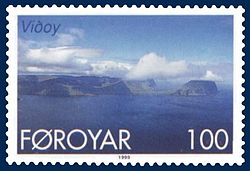Viðoy
| Viðoy | |
|---|---|
| Island | |

Stamp FR 349 of Postverk Føroya (issued: 25 May 1999; photo: Per á Hædd)
|
|
 Location within the Faroe Islands |
|
| Coordinates: 62°20′N 6°31′W / 62.333°N 6.517°WCoordinates: 62°20′N 6°31′W / 62.333°N 6.517°W | |
| State | Kingdom of Denmark |
| Constituent country | Faroe Islands |
| Municipality seat | Viðareiði |
| Area | |
| • Total | 41 km2 (16 sq mi) |
| Area rank | 7 |
| Highest elevation | 841 m (2,759 ft) |
| Population (2002) | |
| • Total | 617 |
| • Rank | 7 |
| • Density | 15/km2 (39/sq mi) |
| Time zone | GMT (UTC+0) |
| • Summer (DST) | EST (UTC+1) |
| Calling code | 298 |
Viðoy (Danish: Viderø) is the northern-most island in the Faroe Islands, located east of Borðoy to which it is linked via a causeway. The name means wood island, despite the fact that no trees grow on the island: the name relates to the driftwood that floats in from Siberia and North America.
The island has two settlements: Hvannasund on the south-west coast and Viðareiði on the north-west coast, the northernmost settlement in the Faroes. A road along the west coast of the island connects the two. The island is connected by a road causeway to Norðdepil on Borðoy and a bus service from Klaksvík runs across the causeway to the island.
The island’s northern and eastern coast has been identified as an Important Bird Area by BirdLife International because of its significance as a breeding site for seabirds, especially European storm petrels (500 pairs), black-legged kittiwakes (5300 pairs), Atlantic puffins (25,000 pairs), common guillemots (6700 individuals) and black guillemots (200 pairs).
Viðoy has eleven mountains of which Villingadalsfjall is the northern-most peak in the Faroes. The north coast also has the Enniberg cliff, which at 750 m is the second highest sea-cliff in Europe (after Hornelen, in Norway). The mountains are shown with their overall rank in the Faroe Islands.
...
Wikipedia
